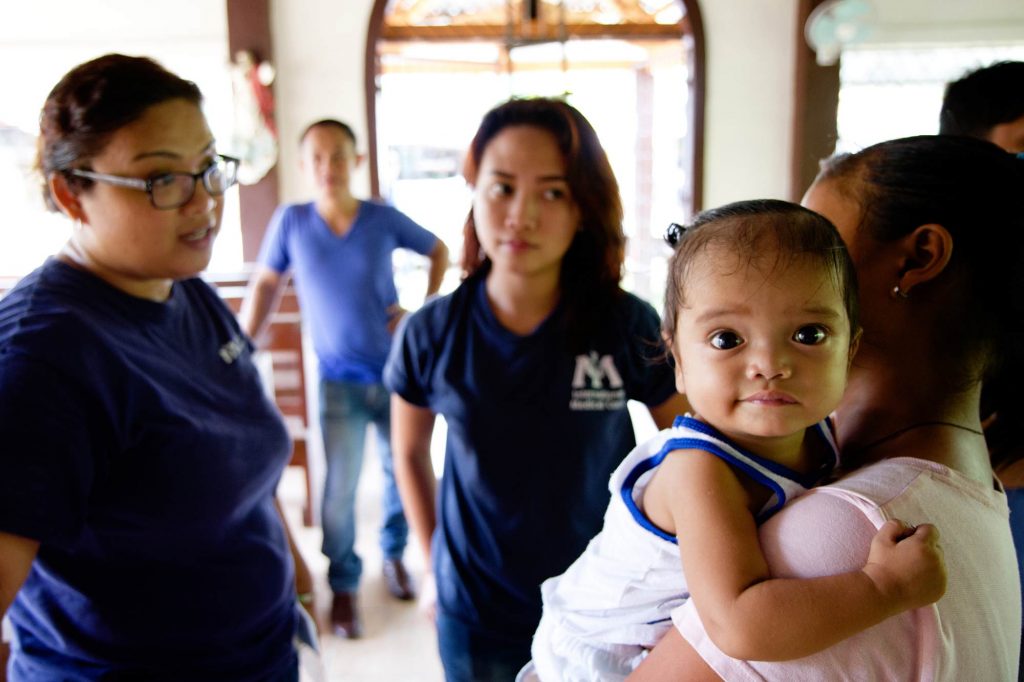
Philippines
The Philippines is an archipelago of more than 7,600 islands in the western Pacific Ocean. Its location along the typhoon belt and the Pacific “Ring of Fire”—home to approximately 90% of the world’s earthquakes—puts the country at high risk for natural disasters and climate-sensitive diseases such as dengue, malaria, diarrhea and cholera. International Medical Corps has been active in the Philippines since November 2013, following Typhoon Haiyan, which affected approximately 16 million people.
Since then, we have responded to several major typhoons that hit the Philippines, including Typhoon Mangkhut/Ompong (2018), typhoons Kammuri/Tisoy and Phanfone/Ursula (2019), typhoons Goni/Rolly and Vamco/Ulysses (2020), Super Typhoon Rai/Odette (2021) and Super Typhoon Gaemi (2024). We also responded to the Taal volcano eruption in 2020, supported the city of Manila during the polio outbreak of 2019, provided services in Laguna province during the dengue epidemic of 2019 and provided COVID-19 services throughout the country during the pandemic. We responded to the 2022 earthquake in Abra with rapid distributions of hygiene supplies, medical supplies and non-food items.

118 million
67/74 years
male/female
22 deaths per 1,000 live births
The Challenges
Our Response

Health
We work to strengthen essential health facilities and prepare the health system for future disasters by restocking medicine, supplies and equipment, and training doctors and nurses working in rural health units about disaster-response medicine. For example, our teams have:
- provided cold-chain support, staff and transportation for several immunization campaigns, including measles and encephalitis campaigns in Benguet province;
- extended logistical support to the Laguna Provincial Hospital-Nagcarlan District Hospital during the 2019 dengue epidemic; and
- provided logistical support to the polio immunization campaign in Manila.
As part of our COVID-19 response, our teams trained more than 400 health workers and community volunteers on infection prevention and control.

Disaster Preparedness and Response
International Medical Corps works with local departments of health to support typhoon-affected populations. For example, our teams have:
- provided diesel generators or solar power to health facilities to ensure proper cold chain and continuity of health services, even during power outages;
- trained staff on disaster risk reduction and the incident command system;
- offered training-of-trainers schooling to health staff about basic life support;
- trained volunteers about basic life support and first aid; and
- trained health workers about advanced cardiac life support.

Water, Sanitation and Hygiene (WASH)
WASH services are among the most urgently needed interventions after typhoons and earthquakes, which cause large-scale infrastructure damage, threaten the health of vulnerable communities and particularly put children at risk for contracting communicable diseases. In response, we focus on ensuring water supply and hygiene in at-risk schools. For example, our teams have:
- rehabilitated WASH systems at 95 schools;
- provided hygiene training to 130 schools;
- trained more than 1,000 teachers on proper hygiene practices;
- trained hundreds of students and teachers to act as hygiene champions and train others; and
- distributed thousands of hygiene kits.
Since 2018, our teams have responded to several natural disasters, providing water-survival and hygiene kits to hundreds of households throughout the country. We rehabilitate toilets in evacuation centers, and construct laundry facilities where needed.
In response to COVID-19, we installed handwashing facilities in health centers throughout Manila and Cavite, and distributed WASH materials—disinfectant, detergent, washcloths, mops, buckets, coveralls, goggles and multipurpose gloves—to people in those health centers.
We Were There: Typhoon Gaemi
In July 2024, Typhoon Gaemi exacerbated already-heavy monsoon rains and dumped up to a foot of water on the main island of Luzon in the Philippines where scores of people were killed and more than 600,000 displaced. Flooding and landslides throughout the region made evacuation and humanitarian efforts challenging, and prompted the government to declare a “state of calamity.” International Medical Corps distributed prepositioned stocks of medicines, medical supplies and essential hygiene items to those affected.
We Were There: Typhoon Mangkhut
On September 14, 2018, Typhoon Mangkhut slammed into northeast Luzon—the Philippines’ largest and most populated island—reportedly producing waves reaching almost 30 feet high, causing excessive flooding, resulting in more than 40 landslides, killing hundreds of people and displacing hundreds of thousands more.
Read moreWe Were There: Typhoon Haiyan
We were on the ground within 24 hours of Typhoon Haiyan in 2013, which left widespread devastation affecting an estimated 16 million people. Our teams provided a comprehensive emergency response, delivering 14,625 health consultations in the first six weeks alone.
Read more

